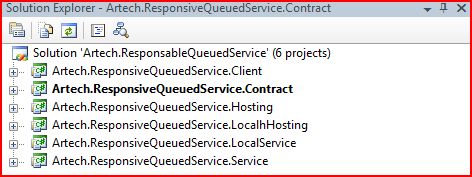wcf创建基于MSMQ的Responsive Service
一、One-way MEP V.S. Responsible Service
我们知道MSMQ天生就具有异步的特性,它只能 以One-way的MEP(Message Exchange Pattern)进行通信。Client和Service之间采用One-way MEP的话就意味着Client调用Service之后立即返回,它无法获得Service的执行结果,也无法捕捉Service运行的 Exception。下图简单表述了基于MSMQ的WCF Service中Client和Service的交互。

但是在有些场景 中,这是无法容忍的。再拿我在上一篇文章的Order Delivery的例子来说。Client向Service提交了Order,却无法确认该Order是否被Service正确处理,这显然是不能接受 的。我们今天就来讨论一下,如何创建一个Responsive Service来解决这个问题:Client不再是对Service的执行情况一无所知,它可以获知Order是否被Service正确处理了。
二、 Solution
虽然我们的目的很简单:当Client向 Service递交了Order之后,能以某种方式获知Order的执行结果;对于Service端来说,在正确把Order从Message Queue中获取出来、并正确处理之后,能够向Order的递交者发送一个Acknowledge Message。为了简单起见,这个Acknowledge Message包含两组信息:
-
Order No.: 被处理的Order的一个能够为一标志它的ID。
-
Exception: 如果处理失败的Exception,如果成功处理为null。
要在WCF中实现这样的目的,对于 Request/Reply MEP来说是简单而直接的:Client向Service递交Order,并等待Service的Response,Service在处理接收到 Order之后直接将处理结果 返回给Client就可以了。但是我们说过MSMQ天生就是异步的,我们只有采取一种间接的方式实现“曲线救国”。
我们的解决方案是:在每个Client Domain也创建一个基于MSMQ的本地的WCF Service,用于接收来自Order处理端发送的Acknowledge Message。对于处理Order 的Service来说,在正确处理Order之后,想对应的Client发送Acknowledge Message。下图简单演示整个过程:

三、Implementation
了解了上面的Solution之后,我们来看看 该Solution在真正实现过程中有什么样的困难。对于处理Order的Service来说,在向Client端发送Acknowledge Message的时候,它必须要知道该Order对应的Client的Response Service的MSMQ的Address以及其他和Operation相关的Context信息(在这里我们不需要,不过考虑到扩展性,我们把包括了 address的Context的信息 封装到一个了Class中,在这里叫做:OrderResponseContext)。而这些Context却不能在Configuration中进行配 置,因为他可以同时面临着很多个Client:比如每个Client用于接收Response 的Message Queue的address都不一样。所以这个OrderResponseContext必须通过对应的Client来提供。基于此,我们具有两面两种解 决方式:
方式一、修改Service Contract,把OrderResponseContext当成是Operation的一个参数
这是我们最容易想到的,比如我们原来的Operation这样定义:
namespace Artech.ResponsiveQueuedService.Contract
{
[ServiceContract]
[ServiceKnownType(typeof(Order))]
public interface IOrderProcessor
{
[OperationContract(IsOneWay = true)]
void Submit(Order order);
}
}
现在变成:
namespace Artech.ResponsiveQueuedService.Contract
{
[ServiceContract]
[ServiceKnownType(typeof(Order))]
public interface IOrderProcessor
{
[OperationContract(IsOneWay = true)]
void Submit(Order order, OrderResponseContext responseContext);
}
}
虽然这种方式看起来不错,但是却不值得推荐。在 一般情况下,我们的Contract需要是很稳定的,一经确定就不能轻易更改,因为Contract是被交互的多方共同支持的,牵一发动全身;此外,从 Service Contract代表的是Service的一个Interface,他是对业务逻辑的抽象、和具体实现无关,而对于我们的例子来说,我们仅仅是定义一个递 交Order的Operation,从业务逻辑来看,OrderResponseContext和抽象的业务逻辑毫无关系。基于此,我们需要寻求一种和 Service Contract无关的解决方式:
方式二、将OrderResponseContext放到Soap Message 的Header中
其实我们要解决的问题很简单,就是要把 OrderResponseContext的信息置于Soap Message中发送到Service。而我们知道,Soap的Header具有极强的可伸缩性,原则上,我们可以把任何控制信息置于Header中。基 于WCF的编程模式很容易地帮助我们实现对Soap Header的插入和获取:
我们可以通过下面的方式获得当前Operation Context的Incoming Message Headers和Outgoing Message Headers
OperationContext.Current.IncomingMessageHeaders OperationContext.Current.OutgoingMessageHeaders
如果我们要把一个OrderResponseContext 对象插入到当前Operation Context的Outgoing Message Headers中,我们可以通过下面的代码来实现:
OrderResponseContext context = new OrderResponseContext();
MessageHeader<OrderResponseContext> header = new MessageHeader<OrderResponseContext>( context);
OperationContext.Current.OutgoingMessageHeaders.Add(header.GetUntypedHeader("name", "namespace"));
相应的,我们可以通过下面的代码从Outgoing Message Headers OrderResponseContext的数据获取的内容:
OrderResponseContext context = OperationContext.Current.IncomingMessageHeaders.GetHeader<OrderResponseContext>("name", "namespace"));
四、Sample
我们照例给出一个完整的Sample,下面是整个Solution的结构:

除了一贯使用的4层结构(Contract-Service-Hosting-Client),还为ResponseService增加了下面两层:
-
Localservice: 作为Client Domain的ResponseService。
-
LocalHosting:Host Localservice。
1.Contract: Artech.ResponsiveQueuedService.Contract
Service Contract: Artech.ResponsiveQueuedService.Contract. IOrderProcessor
using System;
using System.Collections.Generic;
using System.Text;
using System.ServiceModel;
namespace Artech.ResponsiveQueuedService.Contract
{
[ServiceContract]
[ServiceKnownType(typeof(Order))]
public interface IOrderProcessor
{
[OperationContract(IsOneWay = true)]
void Submit(Order order);
}
}
Service Contract: Artech.ResponsiveQueuedService.Contract.IOrderRessponse
using System;
using System.Collections.Generic;
using System.Text;
using System.ServiceModel;
namespace Artech.ResponsiveQueuedService.Contract
{
[ServiceContract]
public interface IOrderRessponse
{
[OperationContract(IsOneWay =true)]
void SubmitOrderResponse(Guid orderNo,FaultException exception);
}
}
接收来自Order processing端的Response:Order No.和Exception。
Data Contract: Artech.ResponsiveQueuedService.Contract.Order
using System;
using System.Collections.Generic;
using System.Text;
using System.Runtime.Serialization;
namespace Artech.ResponsiveQueuedService.Contract
{
[DataContract]
public class Order
{
Private Fields#region Private Fields
private Guid _orderNo;
private DateTime _orderDate;
private Guid _supplierID;
private string _supplierName;
#endregion
Constructors#region Constructors
public Order(Guid orderNo, DateTime orderDate, Guid supplierID, string supplierName)
{
this._orderNo = orderNo;
this._orderDate = orderDate;
this._supplierID = supplierID;
this._supplierName = supplierName;
}
#endregion
Public Properties#region Public Properties
[DataMember]
public Guid OrderNo
{
get { return _orderNo; }
set { _orderNo = value; }
}
[DataMember]
public DateTime OrderDate
{
get { return _orderDate; }
set { _orderDate = value; }
}
[DataMember]
public Guid SupplierID
{
get { return _supplierID; }
set { _supplierID = value; }
}
[DataMember]
public string SupplierName
{
get { return _supplierName; }
set { _supplierName = value; }
}
#endregion
Public Methods#region Public Methods
public override string ToString()
{
string description = string.Format("Order No.\t: {0}\n\tOrder Date\t: {1}\n\tSupplier No.\t: {2}\n\tSupplier Name\t: {3}",
this._orderNo, this._orderDate.ToString("yyyy/MM/dd"), this._supplierID, this._supplierName);
return description;
}
#endregion
}
}
对Order的封装。
Data Contract:Artech.ResponsiveQueuedService.Contract. OrderResponseContext
using System;
using System.Collections.Generic;
using System.Text;
using System.Runtime.Serialization;
using System.ServiceModel;
namespace Artech.ResponsiveQueuedService.Contract
{
[DataContract]
public class OrderResponseContext
{
private Uri _responseAddress;
[DataMember]
public Uri ResponseAddress
{
get { return _responseAddress; }
set { _responseAddress = value; }
}
public static OrderResponseContext Current
{
get
{
if (OperationContext.Current == null)
{
return null;
}
return OperationContext.Current.IncomingMessageHeaders.GetHeader<OrderResponseContext>("OrderResponseContext", "Artech.ResponsiveQueuedService.Contract");
}
set
{
MessageHeader<OrderResponseContext> header = new MessageHeader<OrderResponseContext>(value);
OperationContext.Current.OutgoingMessageHeaders.Add(header.GetUntypedHeader("OrderResponseContext", "Artech.ResponsiveQueuedService.Contract"));
}
}
}
}
ResponseAddress代表Host在Client Domain的Response Service的Address。同过Current把OrderResponseContext插入到Outgoing Message Headers中、以及从Ingoing Message Headers取出OrderResponseContext对象。
2.Order Processing Service:Artech.ResponsiveQueuedService.Service
using System;
using System.Collections.Generic;
using System.Text;
using Artech.ResponsiveQueuedService.Contract;
using System.ServiceModel;
using System.Net.Security;
namespace Artech.ResponsiveQueuedService.Service
{
public class OrderProcessorService:IOrderProcessor
{
private void ProcessOrder(Order order)
{
if (order.OrderDate < DateTime.Today)
{
throw new Exception();
}
}
IOrderProcessor Members#region IOrderProcessor Members
public void Submit(Order order)
{
Console.WriteLine("Begin to process the order of the order No.: {0}", order.OrderNo);
FaultException exception= null;
if (order.OrderDate < DateTime.Today)
{
exception = new FaultException(new FaultReason("The order has expried"), new FaultCode("sender"));
Console.WriteLine("It's fail to process the order.\n\tOrder No.: {0}\n\tReason:{1}", order.OrderNo, "The order has expried");
}
else
{
Console.WriteLine("It's successful to process the order.\n\tOrder No.: {0}", order.OrderNo);
}
NetMsmqBinding binding = new NetMsmqBinding();
binding.ExactlyOnce = false;
binding.Security.Transport.MsmqAuthenticationMode = MsmqAuthenticationMode.None;
binding.Security.Transport.MsmqProtectionLevel = ProtectionLevel.None;
ChannelFactory<IOrderRessponse> channelFacotry = new ChannelFactory<IOrderRessponse>(binding);
OrderResponseContext responseContext = OrderResponseContext.Current;
IOrderRessponse channel = channelFacotry.CreateChannel(new EndpointAddress(responseContext.ResponseAddress));
using (OperationContextScope contextScope = new OperationContextScope(channel as IContextChannel))
{
channel.SubmitOrderResponse(order.OrderNo, exception);
}
}
#endregion
}
}
在这里我们模拟了这样的场景:先通过Order Date判断Order是否过期,如果过期创建一个FaultException,否则正确处理该Order,然后通过 OrderResponseContext.Current从Incoming Message Header中获取封装在OrderResponseContext对象中的Response Address,创建Binding并调用Response Service.
3. Order Processing Service Hosting: Artech.ResponsiveQueuedService.Hosting
Configuration
<?xml version="1.0" encoding="utf-8" ?>
<configuration>
<appSettings>
<add key="msmqPath" value=".\private$\orderprocessor"/>
</appSettings>
<system.serviceModel>
<bindings>
<netMsmqBinding>
<binding name="MsmqBinding" exactlyOnce="false" useActiveDirectory="false">
<security>
<transport msmqAuthenticationMode="None" msmqProtectionLevel="None" />
</security>
</binding>
</netMsmqBinding>
</bindings>
<services>
<service name="Artech.ResponsiveQueuedService.Service.OrderProcessorService">
<endpoint address="net.msmq://localhost/private/orderprocessor" binding="netMsmqBinding"
bindingConfiguration="MsmqBinding" contract="Artech.ResponsiveQueuedService.Contract.IOrderProcessor" />
</service>
</services>
</system.serviceModel>
</configuration>
Program
using System;
using System.Collections.Generic;
using System.Text;
using Artech.ResponsiveQueuedService.Service;
using System.ServiceModel;
using System.Configuration;
using System.Messaging;
namespace Artech.ResponsiveQueuedService.Hosting
{
class Program
{
static void Main(string[] args)
{
string path = ConfigurationManager.AppSettings["msmqPath"];
if (!MessageQueue.Exists(path))
{
MessageQueue.Create(path);
}
using (ServiceHost host = new ServiceHost(typeof(OrderProcessorService)))
{
host.Opened += delegate
{
Console.WriteLine("The Order Processor service has begun to listen");
};
host.Open();
Console.Read();
}
}
}
}
4. Response Service: Artech.ResponsiveQueuedService.LocalService.OrderRessponseService
using System;
using System.Collections.Generic;
using System.Text;
using Artech.ResponsiveQueuedService.Contract;
using System.ServiceModel;
namespace Artech.ResponsiveQueuedService.LocalService
{
public class OrderRessponseService : IOrderRessponse
{
IOrderRessponse Members#region IOrderRessponse Members
public void SubmitOrderResponse(Guid orderNo, FaultException exception)
{
if (exception == null)
{
Console.WriteLine("It's successful to process the order!\n\tOrder No.: {0}",orderNo);
}
else
{
Console.WriteLine("It's fail to process the order!\n\tOrder No.: {0}\n\tReason: {1}", orderNo, exception.Message);
}
}
#endregion
}
}
5. Response Service Hosting: Artech.ResponsiveQueuedService.LocalhHosting
Configuration
<?xml version="1.0" encoding="utf-8" ?>
<configuration>
<appSettings>
<add key="msmqPath" value=".\private$\orderresponse"/>
</appSettings>
<system.serviceModel>
<bindings>
<netMsmqBinding>
<binding name="msmqBinding" exactlyOnce="false">
<security>
<transport msmqAuthenticationMode="None" msmqProtectionLevel="None" />
</security>
</binding>
</netMsmqBinding>
</bindings>
<services>
<service name="Artech.ResponsiveQueuedService.LocalService.OrderRessponseService">
<endpoint address="net.msmq://localhost/private/orderresponse" binding="netMsmqBinding"
bindingConfiguration="msmqBinding" contract="Artech.ResponsiveQueuedService.Contract.IOrderRessponse" />
</service>
</services>
</system.serviceModel>
</configuration>
Program
using System;
using System.Collections.Generic;
using System.Text;
using Artech.ResponsiveQueuedService.LocalService;
using System.Configuration;
using System.ServiceModel;
using System.Messaging;
namespace Artech.ResponsiveQueuedService.LocalhHosting
{
class Program
{
static void Main(string[] args)
{
string path = ConfigurationManager.AppSettings["msmqPath"];
if (!MessageQueue.Exists(path))
{
MessageQueue.Create(path);
}
using (ServiceHost host = new ServiceHost(typeof(OrderRessponseService)))
{
host.Opened += delegate
{
Console.WriteLine("The Order Response service has begun to listen");
};
host.Open();
Console.Read();
}
}
}
}
6. Client: Artech.ResponsiveQueuedService.Client
Configuration:
<?xml version="1.0" encoding="utf-8" ?>
<configuration>
<appSettings>
<add key="msmqPath" value="net.msmq://localhost/private/orderresponse"/>
</appSettings>
<system.serviceModel>
<bindings>
<netMsmqBinding>
<binding name="MsmqBinding" exactlyOnce="false" useActiveDirectory="false">
<security>
<transport msmqAuthenticationMode="None" msmqProtectionLevel="None" />
</security>
</binding>
</netMsmqBinding>
</bindings>
<client>
<endpoint address="net.msmq://localhost/private/orderprocessor" binding="netMsmqBinding"
bindingConfiguration="MsmqBinding" contract="Artech.ResponsiveQueuedService.Contract.IOrderProcessor" name="defaultEndpoint" />
</client>
</system.serviceModel>
</configuration>
Program:
using System;
using System.Collections.Generic;
using System.Text;
using System.Configuration;
using System.ServiceModel;
using Artech.ResponsiveQueuedService.Contract;
using System.Messaging;
namespace Artech.ResponsiveQueuedService.Clinet
{
class Program
{
static void Main(string[] args)
{
Order order1 = new Order(Guid.NewGuid(), DateTime.Today.AddDays(5), Guid.NewGuid(), "Supplier A");
Order order2 = new Order(Guid.NewGuid(), DateTime.Today.AddDays(-5), Guid.NewGuid(), "Supplier A");
string path = ConfigurationManager.AppSettings["msmqPath"];
Uri address = new Uri(path);
OrderResponseContext context = new OrderResponseContext();
context.ResponseAddress = address;
ChannelFactory<IOrderProcessor> channelFactory = new ChannelFactory<IOrderProcessor>("defaultEndpoint");
IOrderProcessor orderProcessor = channelFactory.CreateChannel();
using (OperationContextScope contextScope = new OperationContextScope(orderProcessor as IContextChannel))
{
Console.WriteLine("Submit the order of order No.: {0}", order1.OrderNo);
OrderResponseContext.Current = context;
orderProcessor.Submit(order1);
}
using (OperationContextScope contextScope = new OperationContextScope(orderProcessor as IContextChannel))
{
Console.WriteLine("Submit the order of order No.: {0}", order2.OrderNo);
OrderResponseContext.Current = context;
orderProcessor.Submit(order2);
}
Console.Read();
}
}
}
我创建了两个Order对象, 其中一个已经过期。从Configuration中取出Response Address并购建一个OrderResponseContext,然后分两次将这两个Order向Order Processing Service递交。在调用Order Processing Order的Operation Context Scope中,通过OrderResponseContext.Current将OrderResponseContext对象插入Outcoming Message Header中。
我们现在运行一下整个程序,看看最终的输出结果:
Client:

Order Processing:

Order Response:

Reference:
Build a Queued WCF Response Service
来源:http://www.cnblogs.com/artech/archive/2007/07/01/802069.html
加支付宝好友偷能量挖...

